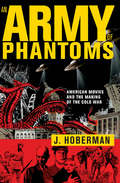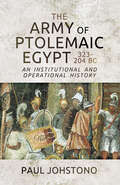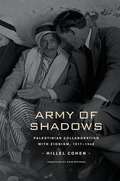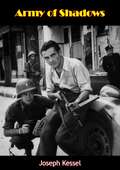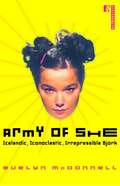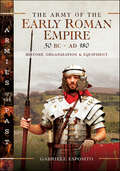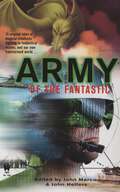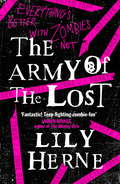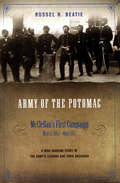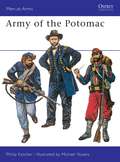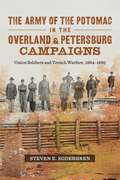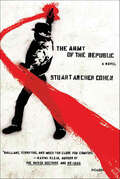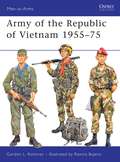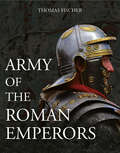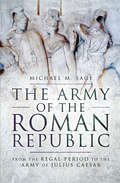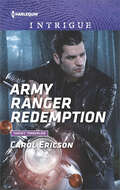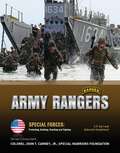- Table View
- List View
An Army of Phantoms: American Movies and the Making of the Cold War
by J. HobermanThe film critic&’s sweeping analysis of American cinema in the Cold War era is both &“utterly compulsive reading [and] majestic&” in its &“breadth and rigor&” (Film Comment). An Army of Phantoms is a major work of film history and cultural criticism by leading film critic J. Hoberman. Tracing the dynamic interplay between politics and popular culture, Hoberman offers &“the most detailed year-by-year look at Hollywood during the first decade of the Cold War ever published, one that takes film analysis beyond the screen and sets it in its larger political context&” (Los Angeles Review of Books). By &“tell[ing] the story not just of what&’s on the screen but of what played out behind it,&” Hoberman demonstrates how the nation&’s deep-seated fears and wishes were projected onto the big screen. In this far-reaching work of historical synthesis, Cecil B. DeMille rubs shoulders with Douglas MacArthur, atomic tests are shown on live TV, God talks on the radio, and Joe McCarthy is bracketed with Marilyn Monroe (The American Scholar). From cavalry Westerns to apocalyptic sci-fi flicks, and biblical spectaculars; from movies to media events, congressional hearings and political campaigns, An Army of Phantoms &“remind[s] you what criticism is supposed to be: revelatory, reflective and as rapturous as the artwork itself&” (Time Out New York). &“An epic . . . alternately fevered and measured account of what might be called the primal scene of American cinema.&” —Cineaste &“There&’s something majestic about the reach of Hoberman&’s ambitions, the breadth and rigor of his research, and especially the curatorial vision brought to historical data.&” —Film Comment
The Army of Ptolemaic Egypt 323–204 BC: An Institutional and Operational History
by Paul JohstonoA study reconstructed through a wide range of ancient sources, from histories to documentary papyri and inscriptions to archaeological finds.The Ptolemaic Dynasty ruled Egypt and much of the eastern Mediterranean basin for nearly 300 years. As a Macedonian dynasty, they derived much of their legitimacy from military activity. As an Egyptian dynasty, they derived much of their real wealth and power from maintaining a secure hold on their new homeland. As lords of a far-flung empire, they maintained much of their authority through garrisons and the threat of military action. To achieve this they devoted much of their activity to the development and maintenance of a large army and navy.This work focuses on the period of the first four Ptolemies, from the acquisition of Egypt after the death of Alexander the Great to the great battle of Raphia more than a century later. It offers a study of the Ptolemaic army as an institution, and of its military operations, both reconstructed through a wide range of ancient sources, from histories to documentary papyri and inscriptions to archaeological finds. It examines the reasons for Ptolemaic successes and failures, the causes and nature of military change and reform, and the particular details of the Ptolemaic army's soldier classes, unit organization, equipment, tactics, and the Ptolemaic state’s strategy to compile a military history of the golden age of one of the classical world's significant forces.
Army of Shadows: Palestinian Collaboration with Zionism, 1917-1948
by Hillel Cohen Haim WatzmanInspired by stories he heard in the West Bank as a child, Hillel Cohen uncovers a hidden history in this book--a history central to the narrative of the Israel-Palestine conflict but for the most part willfully ignored until now. In Army of Shadows, he tells the story of Arabs who, from the very beginning of the Arab-Israeli encounter, sided with the Zionists and aided them politically, economically, and in security matters.
Army of Shadows: The WWII Collection
by Max HennessyGetting shot down is just the beginning in this epic story of survival and resistance in a country crawling with Nazi soldiers during the Second World War. They fought without glory—and without mercy. France, Winter 1944: The long-awaited liberation is at hand. The bombing missions had gone well, and the crew of the Lancaster bomber had begun to relax. Then the Messerschmitt came out of the darkness, its guns blazing. Of the nine-man crew only Neville and Urquhart survive, parachuting into the heart of occupied France. Joining forces with the men of the French Resistance, they must enter a deadly game of cat and mouse with a ruthless enemy . . . A nerve-shredding thriller of the Second World War, steeped in historical research, perfect for fans of Alistair MacLean, Jack Higgins, and Wilbur Smith.
Army of Shadows
by Joseph Kessel Haakon ChevalierTHIS IS THE TRUTH, THOUGH THE FORM IS FICTION…The terrible and inspiring truth about the French underground, the way it’s men and women operate, fight, die, a story full of nobility, heroism, and brutal violence.First published in its English translation in 1944, this is the fictionalized account of French writer Joseph Kessel’s own experiences as a member of the French Resistance in World War II.
Army of She: Icelandic, Iconoclastic, Irrepressible Björk
by Evelyn McdonnellWearing thick glasses, speaking in her thick Icelandic accent, and, well, seeming a touch thick, Björk stormed the public consciousness in 2000 as an unlikely heroine in the experimental musical film Dancer In the Dark. Army of She is an in-depth look at the woman who first took the public stage twenty-three years ago, analyzing her rise from child prodigy to punk anarchist to New Wave novelty (as member of the Sugarcubes) to hit soloist to film star.
An Army of Smiles
by Grace ThompsonThree girls go to war and find true friendship in this Second World War saga from the popular author of the Holidays at Home and Pendragon Island series. Ethel runs away from a violent father, a man so fierce he beat her fiancé senseless. Gorgeous Kate leaves her doting parents and their grocery store. Shy and sheltered Rosie, who has grown up with her grandmother, decides to escape her sleepy hometown. All three join the NAAFI, determined to do their bit against Hitler. Through the travails of war, they become each other&’s new family. Through desperate love affairs, charming pilots, unplanned pregnancies and postings around war-torn Europe, they resolve to stick together. But will the war tear them apart? And when the fighting draws to an end they realize the world—and their lives—can never be the same again . . .
Army Of Terror (Star Wars: Galaxy of Fear #6)
by John WhitmanFollow the adventures of Tash, Zak and their Uncle Hoole as they fight the evil Imperial scientist Borborygmus Gog in this six-volume sequel to Star Wars. Even the most reluctant readers will enjoy this spine-tingling series that explores the dark side of the Star Wars universe.
The Army of the Early Roman Empire 30 BC–AD 180: History, Organization & Equipment
by Gabriele EspositoThe legionary soldier of the early Empire period, with his distinctive segmented armor, is one of the images most closely associated by popular imagination with ancient Rome. Such soldiers conquered most of Britain, suffered and avenged the terrible disaster of the Teutoburg Forest and vanquished the fearsome Dacians across the Danube, a feat immortalized on Trajan’s Column, as well as fighting many other tribes. In the East they overcame the Great Jewish Revolt and repeatedly contended with mixed success against the powerful Parthians. This was the army that enforced the so-called Pax Romana at the point of a gladius and maintained the greatest empire the world had yet seen. Of course, such troops were also employed to bloody effect in the many civil wars such as those of AD69, ‘the Year of the Four of the Emperors’. Gabriele Esposito describes the tactics, organization and equipment of the Roman army at the height of its powers, considered by many to be the most efficient and powerful fighting force of the ancient world. He gives an overview of the most significant campaigns and considers in detail not only the iconic legionaries but also the various auxiliary units, including cavalry. His clear, accessible text is supported by dozens of color photos of replica weapons, armor and other kit in use.
Army of the Fantastic
by John Helfers John Marco13 original tales of fantastical battles for anyone who needs a dose of un-reality. How might the course of World War II have changed if civilized dragons ran bombing missions for the Germans? Here are 13 tales of war in alternate worlds where magical creatures are real and often prove victorious. Human troops fight alongside gryphons, unicorns, and a sea serpent, who can give submarine warfare a whole new slant. These are just a few of the stories gathered together in this all-original volume that opens the way to magical places in our own world where the armies of the fantastic are on the march, waging wars both vast and personal.
The Army Of The Lost
by Lily HerneOne of us is dead. One of us is broken. One of us will betray the others. And one of us will have to sell her soul to survive . . .It’s been eleven years since South Africa was ravaged by the walking dead. Johannesburg's impoverished survivors are ruled over by a minority of rich self-serving bureaucrats. As the remaining Mall Rats confront the dark heart of the twisted political system - in another part of town, Tommy dreams of joining the Army of the Left, a radical organisation intent on fighting for freedom.While Ash is forced to face his traumatic past, and Ginger struggles to regain his sanity; Lele goes head to head against a powerful foe, and Saint is dead set on a mission of her own: a fight for survival. Welcome back to the Deadlands . . .
Army of the Potomac: McClellan's First Campaign, March 1862–May 1862
by Russel H. BeatieThe third volume of this masterful Civil War history series covers the pivotal early months of General George McClellan&’s Peninsula Campaign. As he did in his first two volumes of this magisterial series, Russel Beatie tells the story largely through the eyes and from the perspective of high-ranking officers, staff officers, and politicians. This study is based upon extensive firsthand research (including many previously unused and unpublished sources) that rewrites the history of Little Mac&’s inaugural effort to push his way up the peninsula and capture Richmond in one bold campaign. In meticulous fashion, Beatie examines many heretofore unknown, ignored, or misunderstood facts and events and uses them to evaluate the campaign in the most balanced historical context to date. Every aspect of these critically important weeks is examined, from how McClellan&’s Urbanna plan unraveled and led to the birth of the expedition that debarked at Fort Monroe in March 1862, to the aftermath of Williamsburg. To capture the full flavor of their experiences, Beatie employs the &“fog of war&” technique, which puts the reader in the position of the men who led the Union army. The Confederate adversaries are always present but often only in shadowy forms that achieve firm reality only when we meet them face-to-face on the battlefield. Well written, judiciously reasoned, and extensively footnoted, McClellan&’s First Campaign will be heralded as the seminal work on this topic. Civil War readers may not always agree with Beatie&’s conclusions, but they will concur that his account offers an original examination of the Army of the Potomac&’s role on the Virginia peninsula. &“If you want to understand the war in the east, this series is essential.&” —Civil War Books and Authors
Army of the Potomac: The Civil War Letters of William Cross Hazelton of the Eighth Illinois Cavalry Regiment
by Peter G. BeidlerA riveting, on-the-ground account of the American Civil War by a Union cavalryman who survived most of the historic conflict’s biggest battles. William Cross Hazelton spent four years in the Civil War as a brave and devoted member of the Union cavalry. During that time he corresponded with Fannie Morrill, the young woman who would become his wife. His letters describe the life of an Illinois volunteer in the Army of the Potomac, the military unit that fought Lee’s Army of Northern Virginia in most of the big battles of the Civil War: Williamsburg, Richmond, Antietam, Fredericksburg, Chancellorsville, and Gettysburg. Hazelton describes the battles from the viewpoint of an ordinary cavalryman slogging through the mud, following erratic orders, surviving for days on enemy turf eating nothing but hardtack, and wondering why the Union army, though superior in numbers and supplies, kept losing battles. Later, when Lincoln was assassinated, Hazelton became part of the cavalry posse that chased John Wilkes Booth across the Potomac. His letters breathe new life into a war so devastating that it still scars the American psyche, while exhibiting a moral perspective far ahead of its time. Army of the Potomac is an essential, eye-opening account of one of America’s most harrowing epochs, and was a finalist in the 2013 Next Generation Indie Book Awards.
Army of the Potomac
by Michael Youens Philip KatcherFor General George B. McClellan, the dejected Union troops who poured into Washington fresh from defeat at Bull Run on Monday, July 22, 1861, were to provide the raw material which he would train, equip, organize and ultimately transform from a mere mob into an effective fighting force. In October 1861, the Army of the Potomac officially came into being. This entertaining volume from the same team of author Philip Katcher and artist Michael Youens who produced Men-at-Arms 37, The Army of Northern Virginia, explores how this transition came about, with a particular emphasis on weapons, uniforms and equipment.
The Army of the Potomac in the Overland and Petersburg Campaigns: Union Soldiers and Trench Warfare, 1864-1865
by Steven E. SodergrenThe final year of the Civil War witnessed a profound transformation in the practice of modern warfare, a shift that produced unprecedented consequences for the soldiers fighting on the front lines. In The Army of the Potomac in the Overland and Petersburg Campaigns, Steven E. Sodergren examines the transition to trench warfare, the lengthy campaigns of attrition that resulted, and how these seemingly grim new realities affected the mindset and morale of Union soldiers.The 1864 Overland Campaign created tremendous physical and emotional suffering for the men of the Army of the Potomac as they faced a remarkable increase in the level and frequency of combat. By the end of this critical series of battles, surviving Union soldiers began to express considerable doubt in their cause and their leaders, as evidenced by widespread demoralization and the rising number of men deserting and disobeying orders. Yet, while the Petersburg campaign that followed further exposed the Army of the Potomac to the horrors of trench warfare, it proved both physically and psychologically regenerative. Comprehending that the extensive fortification network surrounding them benefitted their survival, soldiers quickly adjusted to life in the trenches despite the harsh conditions. The army’s static position allowed the Union logistical structure to supply the front lines with much-needed resources like food and mail—even a few luxuries. The elevated morale that resulted, combined with the reelection of Abraham Lincoln in November 1864 and the increasing number of deserters from the Confederate lines, only confirmed the growing belief among the soldiers in the trenches that Union victory was inevitable. Taken together, these aspects of the Petersburg experience mitigated the negative effects of trench warfare and allowed men to adapt more easily to their new world of combat.Sodergren explores the many factors that enabled the Army of the Potomac to endure the brutal physical conditions of trench warfare and emerge with a renewed sense of purpose as fighting resumed on the open battlefield in 1865. Drawing from soldiers’ letters and diaries, official military correspondence, and court-martial records, he paints a vivid picture of the daily lives of Union soldiers as they witnessed the beginnings of a profound shift in the way the world imagined and waged large-scale warfare.
The Army of the Republic: A Novel
by Stuart Archer CohenIn an America stretched by crisis to the breaking point, billionaire entrepreneur and government insider James Sands is riding high. Over the protests of civic groups and the increasing alienation of his wife, Anne, Sands is poised on the brink of an immensely risky and controversial deal that will give him control of all public water in the Pacific Northwest. But when his business partner is murdered by a radical group called The Army of the Republic, Sands finds himself losing control of his business and his life. Desperate, he turns to Whitehall Security, a private intelligence firm with far-reaching political connections. For a steep monthly fee, Whitehall will hunt down and eliminate any threats to Sands's enterprise.Meanwhile, in Seattle, a young guerrilla named Lando leads The Army of the Republic into a dangerous war of ideals. Charismatic and cunning, Lando is obsessed with the goal of saving the country from its corrupt ruling alliance by any means necessary. His reluctant ally is political organizer Emily Cortright, coordinator of a network of civil, religious, and labor groups. Bound together in a web of common aims and conflicting loyalties, the two plan a massive peaceful protest against a conference of national business leaders, which they hope will stagger the Regime.Beyond his control, through, Lando's Army of the Republic has already unleashed a chain of events that will electrify and frighten an uneasy nation. Hemmed in by their lethal compromises, Emily, Lando, James, and Anne struggle to redeem or destroy those whom they love most.Thrilling and unforgettable, The Army of the Republic is a brilliant, provocative novel about what it means to live in a democracy.
Army of the Republic of Vietnam 1955-75
by Ramiro Bujeiro Gordon RottmanRottman's latest title discusses the original reorganization of Vietnam forces, from the original colonial structure implemented by the French into the first national army of Vietnam. Complete with a detailed history of the command structure and orders of battle, Rottman sheds light on the little known divisional histories of the army through rare, original source material. Moreover, the author examines in detail the evolution of such key units as armoured forces, ranger commands as well as combat unit organization. This, together with a detailed analysis of the experiences of the typical rank and file soldier as well as officer corps, provides a concise and and in-depth history of an army that is too often neglected or quickly judged.
Army of the Roman Emperors: Archaeology And History
by Thomas FischerAn illustrated history exploring the Imperial Roman army&’s many facets, including uniforms, weapons, buildings, and their duties. Compared to modern standard, the Roman army of the Imperial era was surprisingly small. However, when assessed in terms of their various tasks, they by far outstrip modern armies—acting not only as an armed power of the state in external and internal conflicts, but also carrying out functions nowadays performed by police, local government, customs, and tax authorities, as well as constructing roads, ships, and buildings. With this volume, Thomas Fischer presents a comprehensive and unique exploration of the Roman military of the Imperial era. With over 600 illustrations, the costumes, weapons and equipment of the Roman army are explored in detail using archaeological finds dating from the late Republic to Late Antiquity, and from all over the Roman Empire. The army&’s buildings and fortifications are also featured. Finally, conflicts, border security, weaponry, and artifacts are all compared, offering a look at the development of the army through time. This work is intended for experts as well as to readers with a general interest in Roman history. It is also a treasure-trove for re-enactment groups, as it puts many common perceptions of the weaponry, equipment, and dress of the Roman army to the test.
The Army of the Roman Republic: From the Regal Period to the Army of Julius Caesar
by Michael SageFrom the moment its last king was expelled (traditionally in 753) the Roman republic had to fight for its very survival. Centuries of almost continuous warfare saw Romes armies evolve in response to a wide variety of threats which were met with mixed fortunes though always with ultimate success. As defence of the homeland turned to territorial expansion, Roman forces also had to adapt to sustained campaigns in varied terrain and climates, not to mention the changes in the Roman republic itself. Michael Sage traces the development of the republics army from its foundation (having first set the context of their regal antecedents), down to the time of its most famous leader, Julius Caesar. The transition from clan-based forces, through the Servian levy and the development of the manipular and cohortal legion is examined along with the associated weapons, tactics and operational capabilities. We see how the legions shaped up against the challenges of successive enemies from the Celts and Samnites, the Carthaginians and the hitherto-dominant Hellenistic armies based on the Macedonian-style pike phalanx.
Army Ranger Redemption: Still Waters Army Ranger Redemption Cowboy Cavalry (Target: Timberline #3)
by Carol EricsonA war hero fights for what he lost long ago The Timberline Trio was the cold case everyone in town was doomed to remember. Scarlett Easton may have just been a child then, but the fear it spread throughout the reservation haunts her to this day. Jim Kennedy ran off to war to escape this place, and has now returned to fight his own battle on the home front. And when that puts Scarlett in danger, both their loyalties will be tested. Finding themselves on opposite sides of a town that's never recovered from the kidnappings decades ago, Jim and Scarlett discover that not only are their pasts forever tied together, but so are their futures...
Army Rangers (Special Forces: Protecting, Building, Te)
by C. F. EarlThe Rangers are some of the best-trained and most skilled soldiers in the Army. Their motto--Rangers lead the way!--is not just a slogan; in many of the modern conflicts in which the U.S. military has been involved, the Rangers have been among the first soldiers on the ground. In both Iraq and Afghanistan, Rangers carry out raid, ambush, and rescue missions, as well as many other kinds of operations. Army Rangers gives readers a view into the world of the highly skilled Seventy-Fifth Ranger Regiment, today's Rangers, as well as a look at the history of the unit. Since the Revolutionary War, Ranger tactics and standards have been some of the most effective in the entire military. The book also includes information about: * The tough training courses that all Rangers must endure. * What kinds of weapons the Rangers use today and throughout history. * How the modern Rangers were organized and put into action around the world.
The Army Ranger's Return
by Soraya LaneA soldier's second chance... As nervous as a teenager about to go on her first date, Jessica Mitchell waits for Special Forces Ranger Ryan McAdams-her best friend for the past year- whom she's never met! They've been pen pals while Ryan was away fighting for their country and Jessica was secretly fighting her own demons back home. She knows widower Ryan's fears of returning to civilian life and his hopes of reconnecting with his son. Now she can't wait to meet him face-to-face-to hear his voice and see his smile...
Army Science And Technology For Homeland Security: Report 2
by Committee on Army Science Technology for Homeland Defense--C4ISRShortly after the events of September 11, 2001, the U.S. Army asked the National Research Council (NRC) for a series of reports on how science and technology could assist the Army meet its Homeland defense obligations. The first report, Science and Technology for Army Homeland Security—Report 1, presented a survey of a road range of technologies and recommended applying Future Force technologies to homeland security wherever possible. In particular, the report noted that the Army should play a major role in providing emergency command, control, communications, computers, intelligence, surveillance, and reconnaissance (C4ISR) capabilities and that the technology and architecture needed for homeland security C4ISR was compatible with that of the Army’s Future Force. This second report focuses on C4ISR and how it can facilitate the Army’s efforts to assist the Department of Homeland Security (DHS) and emergency responders meet a catastrophic event.
Army Special Forces Training For The Global War On Terror
by Major Daniel C. MollWith USSOCOM assuming the role as supported command in the Global War on Terror, Army Special Forces will no doubt to play a primary role in that effort. The unspoken assumption seems to be that America's new, unconventional foe will best be combated with America's own unconventional warriors. It is unclear, however, if a force raised to conduct behind-the-lines operations against a large conventional enemy will remain the force of choice against al-Qaida and similar threats. This thesis' central research question is: Is US Army Special Forces adequately prepared, and trained to fight the Global War on Terror? This thesis examines the contemporary operating environment, the threat represented by al-Qaida, and whether it represents a traditional terrorist threat or a new, transnational insurgency. A review of both types of organization over the last century indicates that al-Qaida is, at this stage, merely a terrorist organization, and not an insurgency. However, al-Qaida sprang from a region that is ripe for insurgency should the terrorists choose to become more than what they currently are. Combating the threat posed by al-Qaida, then, seems to require both an aggressive counter-terrorist campaign and a simultaneous pre-emptive counter-insurgency. A review of current training indicates that Special Forces appears well prepared for both efforts with one glaring deficiency: foreign language proficiency.
